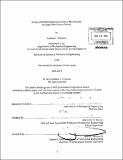Design and optimization of actuation mechanisms for rapid skin closure device
Author(s)
Erickson, Andrew T. (Andrew Thomas)
DownloadFull printable version (18.11Mb)
Other Contributors
Massachusetts Institute of Technology. Dept. of Mechanical Engineering.
Advisor
Alexander H. Slocum.
Terms of use
Metadata
Show full item recordAbstract
Innovative mechanism designs were explored for the actuation of critical components in a novel rapid skin closure device used to close long surgical incisions. The rapid skin closure device is designed to speed up the wound closure process and achieve the aesthetic results of a plastic surgeon by automatically placing bio-absorbable adjustable clips in the dermal layer of skin along a surgical incision. Precise alignment of the wound edges, deployment of needles preloaded with clips, and the successful connection of the two clip ends inside the wound are critical for the proper function of the device. The iterative design of the actuating mechanisms for the skin alignment, needle deployment, and successful clip connection were accomplished in four prototypes. The first two prototypes demonstrated the proof of concept that needles could follow a pre-determined path and two ends of a clip could be reliably connected. The second pneumatically actuated prototype connected over a hundred clips in a row and measured a repeatability of 98%. The third and fourth prototypes focused on refining the design into a production product by reducing the size, complexity, and cost. Many types of actuators and power transmission components were used, combined, and compared. It was found that the skin alignment could be reduced to a passive rail system that did not require an actuator. Furthermore, the needle and ejector pin motions critical for the success of placing a clip were combined into a single actuating motion. The combination was made possible by a series of nested cylinders separated by a stiff compression spring, and actuated by a slotted angled bar that optimized efficiency. All electronics were eliminated from the device with the inclusion of a manually actuated handle to drive the main slotted bar. The results from testing in human skin revealed that the needle deployment and clipping were successful, but the passive rail alignment failed due to the elastic nature of the tissue. Further refinement will be required to make the device production ready. However, the innovative designs from this research will have a significant impact on the success of the device as a product.
Description
Thesis (S.B.)--Massachusetts Institute of Technology, Dept. of Mechanical Engineering, 2012. Cataloged from PDF version of thesis. Includes bibliographical references (p. 116).
Date issued
2012Department
Massachusetts Institute of Technology. Department of Mechanical EngineeringPublisher
Massachusetts Institute of Technology
Keywords
Mechanical Engineering.